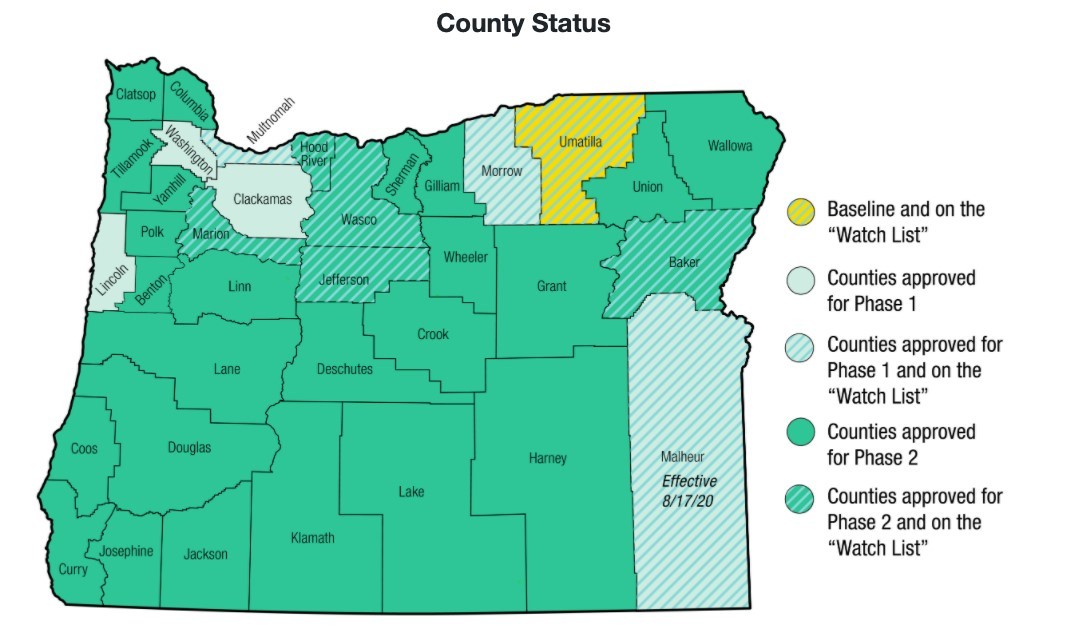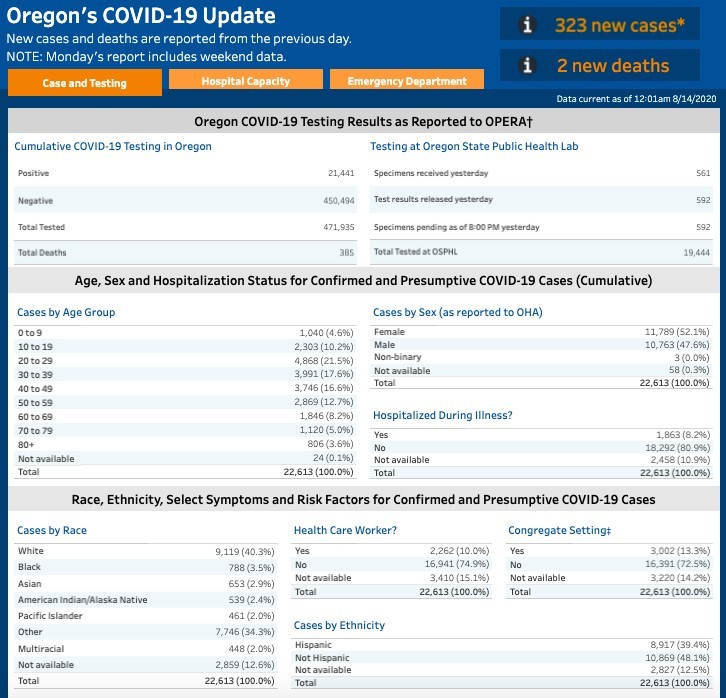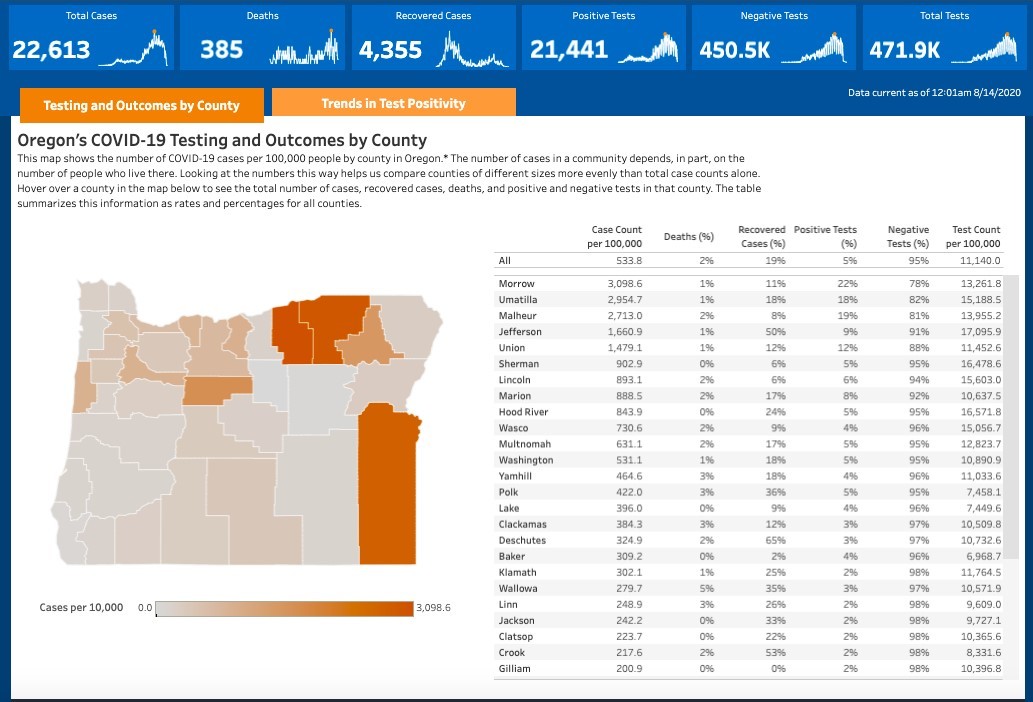|
Dear Friends and Neighbors,
As we head into a dry, hot weekend, please take care of yourselves and stay cool. If you’re out camping, please do everything you can to reduce this risk of wildfires (for campfire tips in English go here and for tips in Spanish go here).
This week, we received more encouraging news from the state’s weekly COVID-19 report, which can be read in full here.
- From August 3 through August 9, OHA recorded 2,122 new cases of COVID-19 infection. This is down slightly from last week’s tally of 2,278.
- Hospitalizations have stabilized in recent weeks: 143 were reported, only slightly above 141 from the previous week.
- There were 29 recorded deaths during that period, down from the previous week’s total of 39.
- The percentage of positive tests decreased from 6.4% to 5.4%.
Of course, the virus continues to cause immense challenges. Yesterday, Governor Brown announced that Malheur County would return to Phase 1 reopening starting on Monday and be there for at least the next three weeks. The county, along the Oregon-Idaho border, has a case rate of 266 cases per 10,000 people, which is the third highest county case rate in the state. Additionally, the county has had a test positivity rate of 26% over the last two weeks. This is well above the state average for that timeframe (5.8%), and a majority of new cases could not be traced back to a known source. It certainly doesn’t help that southwest Idaho is one of the nation’s COVID-19 hot spots.
This change in Malheur County’s reopening comes two weeks after Umatilla County returned to baseline status and Morrow County moved back to Phase 1, due to the growing spread of the virus in each county. The map below shows the counties on the Governor’s Watch List – the list where counties are placed for at least three weeks when COVID-19 is spreading quickly and public health officials cannot trace that spread to specific sources.
So, another week of good news and bad news. I remain hopeful, despite everything, that we can make progress on containing the spread of infection. We can get through this, so long as we each make the commitment to do all we can to protect each other.
Here is the latest status update for each Oregon county:

A new study done by public health experts at the Oregon Health Authority shows that back in May and June, 1% of Oregonians without COVID-19 had evidence of past infection of the virus in their blood, a percentage that is 10 times higher than the reported rate of infections obtained through conventional testing.
The study appears today in the Centers for Disease Control and Prevention’s Morbidity and Mortality Weekly Report. It found that nine of 897 blood specimens collected from 19 health care facilities around Oregon between May 11 and June 15, 2020, contained antibodies against the virus that causes COVID-19. The results indicate a "substantial" proportion of Oregon residents have undiagnosed and unreported infection from COVID-19.
"We suspected that a much larger segment of Oregon’s population has been exposed to and infected with COVID-19 than traditional diagnostic testing shows," said Paul Cieslak, M.D., a study co-author and OHA medical director for communicable diseases and immunizations. "But these results also tell us that the great majority of Oregonians remain susceptible to this virus."
For more information on this study, go here.
What does this tell us? Even if you feel fine, you might have COVID, and therefore you can make others sick. So, please – wear a mask, wash your hands, and watch your distance from others.
Having safe, consistent shelter during this pandemic is essential for stemming the spread of the coronavirus. As I noted in Wednesday's newsletter, I’m concerned that recent reporting shows that a declining number of Oregonians were able to make their August rent payments.
When legislators met back in June, we strengthened and extended a temporary ban on residential and commercial evictions. We also passed some foreclosure protections, that the Oregon Bankers Association is trying to undo (for more on that story, go here).
This week, Oregon Housing and Community Services and the Oregon Law Center released helpful information for tenants about the residential eviction moratorium.
This guidance, which I’ve posted below, has been translated into Spanish, Hmong, Arabic, Korean, Russian, Somali, Marshallese, Chinese (traditional and simplified), Chuukese, and Vietnamese – which can be found here.
STEP 1: Know Your Rights
The Oregon Legislature passed a law so landlords in Oregon can’t do the following until October 1st:
- Give a notice of termination for nonpayment of rent or fees due between April 1 and September 30;
- Give a notice of termination without cause;
- Report unpaid rent or fees to credit agencies; or
- Charge fees for late rent.
After the eviction moratorium ends on October 1, renters have until March 31, 2021 to catch up on any rent payments they missed between April and October 2020. But landlords can give notices of termination or file evictions for other reasons, both during and after the moratorium. Get more information at OregonLawHelp.org.
STEP 2: Write to Your Landlord
If you think you might struggle to pay rent, tell your landlord in writing and save a copy. Many programs assist renters prior to falling behind or help renters get caught up on rent. Ask for help right away.
STEP 3: CALL 2-1-1 or Visit 211.info.org
Contact the Community Action Agency (CAA) near you. You may qualify for help with rent, energy, and more. CAAs provide information for free. Due to the large number of requests, there may be a waiting period to qualify for and/or get assistance.
STEP 4: Gather Information
In addition to state and federal assistance, some local programs, non-profits, or religious organizations might be able to help. Also, you may be able to set up a partial payment plan with your landlord. This option is voluntary but could help reduce the back rent that you owe at the end of the grace period (March 2021). Information is changing rapidly, so continue to look for news from the Governor’s office, state agencies, and trusted organizations.
STEP 5: Get Ready
If you don’t pay October’s rent, your landlord can give you a notice of termination for nonpayment of October’s rent, and then file for eviction if you don’t pay your rent. You may also get a notice from your landlord requiring you to tell them within 14 days if you plan to use the six-month grace period to pay back any outstanding rent. You must respond and tell your landlord if you plan to use the grace period. (It’s best to respond in writing, and to keep a copy.)
The Oregon Law Center and the Community Alliance of Tenants have sample letters you can use to let your landlord know that you plan to use the grace period. If you don’t tell your landlord, they can charge a penalty of half of one month’s rent, after March 31, 2020. Remember, you have to catch up on any rent you didn’t pay between April and October 2020 by March 31, 2021. This information can be complex. Please visit The Oregon Law Center and the Community Alliance of Tenants websites for more in-depth information.
Lastly, please take care of yourself.
These are difficult times and continued stress can affect sleep, mental health and relationships. 211 provides resources and NAMI Oregon has a free mental health hotline for support.
- The Kaiser Permanente Center for Health Research is recruiting at least 100 Oregonians to participate in one of the state’s first vaccine trials for COVID-19, The Oregonian reports here.
- In addition to the Pac-12 deciding to postpone fall sports, the same decision has been made by the University of Portland and Portland State University. The Oregonian has more information here and here.
- The Oregon Health Authority reported 323 new confirmed cases of coronavirus, bringing the statewide total of new and presumptive cases to 22,613. Sadly, two more people have died, meaning there have been 385 Oregonians to die of the coronavirus. On Thursday, OHA reported 294 new cases and eight deaths. You can click the images below for links to interactive data tables about coronavirus in Oregon.



To read past newsletters, you can go to this link. For up to date information, please check this link to the Oregon Health Authority where regular updates are posted: https://www.oregon.gov/oha/ERD/Pages/News-Releases.aspx
Please email me at Rep.TinaKotek@oregonlegislature.gov if you have specific concerns that have not been addressed by the OHA. Our office will do all we can to help and protect all Oregonians.
Thank you for reading! We will get through this together.
Best,

Tina Kotek
State Representative
House District 44
Speaker of the House
email: Rep.TinaKotek@oregonlegislature.gov I phone: 503-986-1200
address: 900 Court St NE, H-269, Salem, OR 97301
website: http://www.oregonlegislature.gov/kotek
|